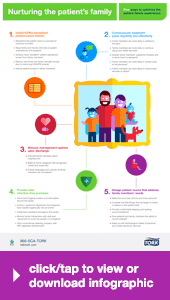Patient satisfaction scores are gaining ground as indicators of a hospital or healthcare facility’s ability to deliver quality patient care and improve clinical outcomes. Satisfaction scores, however, are not always based on the patient or customer’s experience alone. They also extend to family members and caregivers who are just as much a part of the patient’s treatment and recovery process.
 Today, hospitals need to make sure they’re taking care of family members’ needs just as well as those of their patients. Why is that necessary? Because the patient’s satisfaction with their care is so strongly dependent on the experience and impressions that family and caregivers have during and after the hospital stay.
Today, hospitals need to make sure they’re taking care of family members’ needs just as well as those of their patients. Why is that necessary? Because the patient’s satisfaction with their care is so strongly dependent on the experience and impressions that family and caregivers have during and after the hospital stay.
It all starts at check-in and the very first day the patient arrives at the hospital. Family members, naturally concerned about their patient’s well-being and treatment, may need constant reassurance. A simple way to keep them updated and aware of their patient’s whereabouts is to install HIPAA-compliant status boards that track the patient’s progress throughout their visit.1 It relieves anxiety and boosts confidence in the system. Additionally, communicating treatment plans honestly, frequently and in terms family members can understand is just as important to reducing worry among family members.2 Both these strategies can vastly improve outcomes and boost satisfaction.
Part of reducing family members’ stress and concerns also comes from understanding their cultural and language needs. Doing so makes them feel recognized, valued and supported in their roles as caregivers. Additionally, it’s important to cater to their needs in a patient’s hospital room. While the patient stays in bed for the most part, the family members are making use of the rest of the space, which means design and functionality are also key considerations. Providing the basic necessities they are accustomed to like comfortable sleeping and seating areas and Wi-Fi can allow them to manage their day with minimal disruption and discomfort.3
Thinking of ways to treat family members like the guests they are will help to ensure you provide safe, comfortable and clean premises which results in less complaints and higher recommendations and reviews for your facility.
References:
1 Versus, Benefits. Retrieved from http://www.versustech.com/rtls-benefits/patients/
2 3. Davidson, J. et al. (2007), Clinical practice guidelines for support of the family in the patient-centered intensive care unit: American College of Critical Care Medicine Task Force 2004–2005. Retrieved from http://www.learnicu.org/docs/guidelines/patient-centeredintensive.pdf
3 5. Phillips, T., Allison, D., Garvey, T (2013), Balancing Clinical Care Needs with Optimizing the Patient and Family Experience: A case for interdisciplinary design research and collaboration. Retrieved from http://www.iidexcanada.com/2015/uploads/03Balancing_Clinical_Care_Needs_with_Optimizing_the_Patient_and_Family_Experience_-_Tamara_Phillips.pdf
